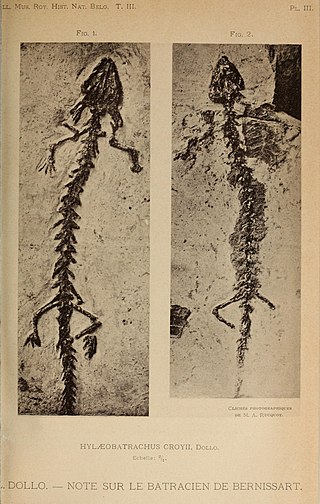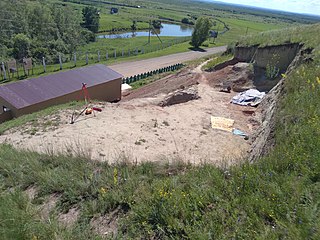
The Cryptobranchidae are a family of fully aquatic salamanders commonly known as the giant salamanders. They include the largest living amphibians. The family is native to China, Japan, and the eastern United States. They constitute one of two living families—the other being the Asiatic salamanders belonging to the family Hynobiidae—within the Cryptobranchoidea, one of two main divisions of living salamanders.

Karaurus is an extinct genus of stem-group salamander (Caudata) from the Middle to Late Jurassic (Callovian–Kimmeridgian) Karabastau Formation of Kazakhstan. It is one of the oldest salamanders known.

The Cryptobranchoidea are a suborder of salamanders found in Asia, European Russia, and the United States. They are known as primitive salamanders, in contrast to Salamandroidea, the advanced salamanders. It has two living subdivisions, Cryptobranchidae, which includes Asian giant salamanders and hellbenders, and Hynobiidae, commonly known as Asian salamanders.

The Albanerpetontidae are an extinct family of small amphibians, native to the Northern Hemisphere during the Mesozoic and Cenozoic. The only members of the order Allocaudata, they are thought to be allied with living amphibians belonging to Lissamphibia. Despite a superficially salamander-like bodyform, their anatomy is strongly divergent from modern amphibians in numerous aspects. The fossil record of albanerpetontids spans over 160 million years from the Middle Jurassic to the beginning of the Pleistocene, about 2.13–2 million years ago.
Eoscapherpeton is an extinct genus of giant salamander, known from the Late Cretaceous of Central Asia. Fossils have been found in the Cenomanian aged Khodzhakul Formation and Dzharakuduk Formation, Turonian aged Bissekty Formation and the Coniacian-Santonian aged Aitym Formation of Uzbekistan, the Santonian aged Yalovach Formation of Tajikistan, and the Santonian-lower Campanian aged Bostobe Formation and Campanian aged Darbasa Formation of Kazakhstan.

Hylaeobatrachus is an extinct genus of prehistoric salamander, known from the Early Cretaceous of Europe. The type species H. croyii is known from the Sainte-Barbe Clays Formation at the Iguanodon locality of Belgium, and was described by Louis Dollo. An unnamed Hylaeobatrachus-like taxon has also been reported from Las Hoyas, Spain. Both localities are of Barremian age. Hylaeobatrachus belongs to the crown group of modern salamanders, though its exact relationship with modern salamander groups is uncertain. It was neotenic, llike some modern salamanders.
Horezmia is an extinct Mesozoic genus of prehistoric salamanders. The fossils have been found in Russia. It is comparable to modern advanced salamanders, though its phylogenetic placement within Salamandroidea is uncertain.
Kokartus is an extinct genus of prehistoric stem-group salamander (Caudata) from the Middle Jurassic Balabansai Formation of Kyrgyzstan.
Valdotriton is a genus of extinct prehistoric salamanders. Its only known species is Valdotriton gracilis. V. gracilis lived during the Late Barremian in what is now Spain. It was found in the Las Hoyas locality. It represents one of the oldest known members of Salamandroidea.

Pangerpeton is an extinct genus of salamanders. Its monotypic species is Pangerpeton sinensis.

Turanosuchus is an extinct genus of paralligatorid crocodyliform. It is based on PIN 2229/507, a partial lower jaw consisting of the area where the two halves of the lower jaw meet. This specimen was found in rocks of the lower Santonian-age Upper Cretaceous Bostobe Svita of Shakh-Shakh, southern Kazakhstan. Turanosuchus was described in 1988 by Mikhail Efimov. The type species is T. aralensis. Halliday et al. (2015) revised the material attributed to T. aralensis and concluded that it represents non-diagnostic neosuchian material, and as such the genus was considered to be a nomen dubium.
The Balabansai Formation is a geological formation in Kazakhstan, Kyrgyzstan and Uzbekistan whose strata date back to the Bathonian and Callovian stages of the Middle Jurassic. Dinosaur remains are among the fossils that have been recovered from the formation. The lithology primarily consists of variegated sandstones, siltstones, claystones, and rare gravels and marls. Many taxa have been found in the formation, including amphibians and mammals
The Itat Formation is a geologic formation in western Siberia. It was deposited in the Bajocian to Bathonian ages of the Middle Jurassic. Dinosaur remains are among the fossils that have been recovered from the formation, including the proceratosaurid Kileskus, as well as fish, amphibians, mammals and many other vertebrates. The formation is noted for bearing significant coal reserves, with large open pit coal mines extracting lignite from the unit currently in operation.

Khurendukhosaurus is a genus of choristodere, a type of amphibious reptile. It is known from Lower Cretaceous rocks of Mongolia and Russia. Two species have been named. The type species, K. orlovi, was named in 1984 by Sigogneau–Russell and Efimov for the fragmentary postcranial skeleton PIN 3386/3. This specimen was discovered in the Albian-age Lower Cretaceous Khuren Dukh Formation Formation at Hüren Dukh, central Mongolia. The lake deposits at this site also contain fossils of the choristoderes Irenosaurus and Tchoiria. Other postcranial bones of K. orlovi have been found at this site as well.

Seminobatrachus is an extinct genus of neotenic salamander from late Paleocene to early Eocene deposits of Cherkassy Region, central Ukraine. It is known from 14 skeletons from a drill hole near Boltyshka village. It was first named by Pavel P. Skutschas and Yuri M. Gubin in 2011 and the type species is Seminobatrachus boltyschkensis.

The Karauridae are a family of stem-group salamanders (Caudata) that are known from the Middle Jurassic to Late Jurassic in Central Asia and Western Europe. The family includes three members: Karaurus from the Middle-Late Jurassic Karabastau Formation of Kazakhstan, Kokartus from the Middle Jurassic Balabansai Formation of Kyrgyzstan, and Marmorerpeton from the Middle Jurassic Forest Marble Formation of England and Kilmaluag Formation of Scotland. The members are some of the oldest known salamanders. The family is united by several morphological characters, including sculptured skull roof bones. Like some modern salamanders, karaurids were neotenic. Members of the family likely fed via suction feeding on small fish and invertebrates. The Early Cretaceous Siberian Kulgeriherpeton has been suggested to be a karaurid by some authors.

The Adocidae are an extinct family of aquatic and omnivorous turtles. They are freshwater cryptodiran turtles and are mainly known from Cretaceous and Paleogene Asia and North America.

The Ilek Formation is a Lower Cretaceous geologic formation in Western Siberia. Many different fossils have been recovered from the formation. It overlies the Late Jurassic Tyazhin Formation and underlies the Albian Kiya Formation.
Tengrisaurus is a genus of lithostrotian sauropod, from the Early Cretaceous (Barremian-Aptian) Murtoi Formation, Russia. It was described in 2017 by Averianov & Skutschas. The type species is T. starkovi. New remains were described in 2021 by Averianov, Sizov & Skutschas.

The Batylykh Formation is a geological formation in Yakutia, Russia. It is of an uncertain Early Cretaceous age, probably dating between the Berriasian and the Barremian. It is the oldest unit of the 1,500 metres (4,900 ft) thick Sangar Series within the Vilyuy syneclise. The mudstones, sandstones and shales of the formation were deposited in a fluvial to lacustrine environment.











